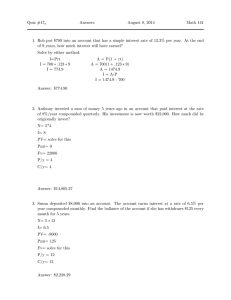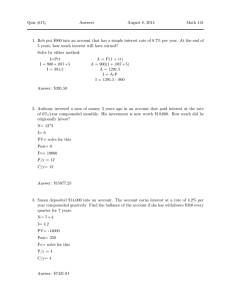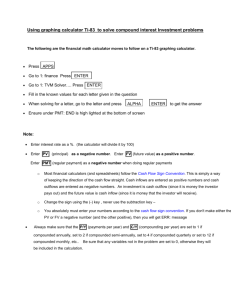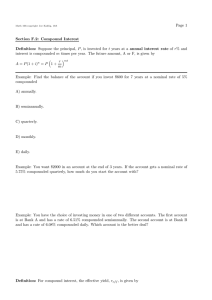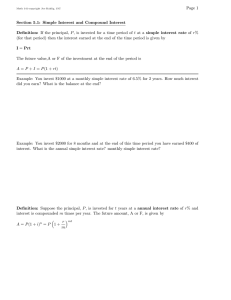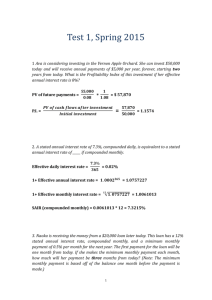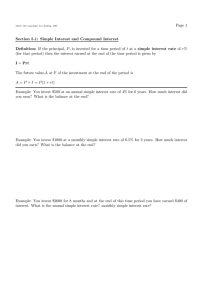Document 10509728
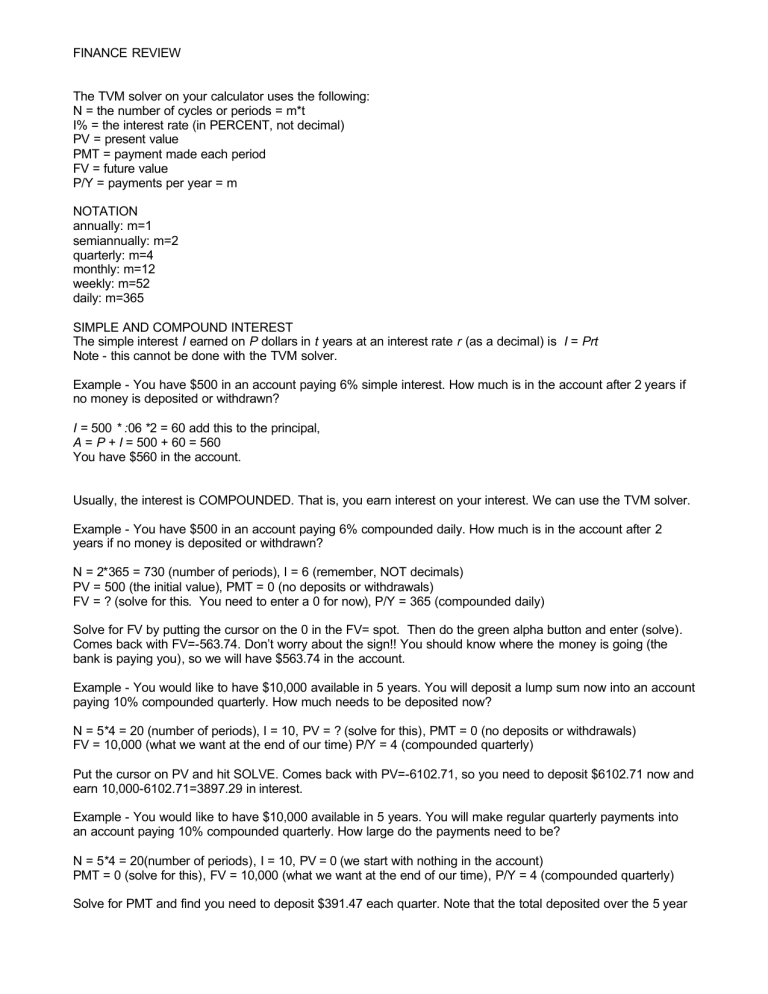
FINANCE REVIEW
The TVM solver on your calculator uses the following:
N = the number of cycles or periods = m*t
I% = the interest rate (in PERCENT, not decimal)
PV = present value
PMT = payment made each period
FV = future value
P/Y = payments per year = m
NOTATION annually: m=1 semiannually: m=2 quarterly: m=4 monthly: m=12 weekly: m=52 daily: m=365
SIMPLE AND COMPOUND INTEREST
The simple interest I earned on P dollars in t years at an interest rate r (as a decimal) is I = Prt
Note - this cannot be done with the TVM solver.
Example - You have $500 in an account paying 6% simple interest. How much is in the account after 2 years if no money is deposited or withdrawn?
I = 500 * : 06 * 2 = 60 add this to the principal,
A = P + I = 500 + 60 = 560
You have $560 in the account.
Usually, the interest is COMPOUNDED. That is, you earn interest on your interest. We can use the TVM solver.
Example - You have $500 in an account paying 6% compounded daily. How much is in the account after 2 years if no money is deposited or withdrawn?
N = 2*365 = 730 (number of periods), I = 6 (remember, NOT decimals)
PV = 500 (the initial value), PMT = 0 (no deposits or withdrawals)
FV = ? (solve for this. You need to enter a 0 for now), P/Y = 365 (compounded daily)
Solve for FV by putting the cursor on the 0 in the FV= spot. Then do the green alpha button and enter (solve).
Comes back with FV=-563.74. Don’t worry about the sign!! You should know where the money is going (the bank is paying you), so we will have $563.74 in the account.
Example - You would like to have $10,000 available in 5 years. You will deposit a lump sum now into an account paying 10% compounded quarterly. How much needs to be deposited now?
N = 5 * 4 = 20 (number of periods), I = 10, PV = ? (solve for this), PMT = 0 (no deposits or withdrawals)
FV = 10,000 (what we want at the end of our time) P/Y = 4 (compounded quarterly)
Put the cursor on PV and hit SOLVE. Comes back with PV=-6102.71, so you need to deposit $6102.71 now and earn 10,000-6102.71=3897.29 in interest.
Example - You would like to have $10,000 available in 5 years. You will make regular quarterly payments into an account paying 10% compounded quarterly. How large do the payments need to be?
N = 5 * 4 = 20(number of periods), I = 10, PV = 0 (we start with nothing in the account)
PMT = 0 (solve for this), FV = 10,000 (what we want at the end of our time), P/Y = 4 (compounded quarterly)
Solve for PMT and find you need to deposit $391.47 each quarter. Note that the total deposited over the 5 year
period is 20 * 391 : 47 = 7829.40. We will earn 10,000 - 7829.40 = 2170.60 in interest.
Example: You are saving for a pair of diamond earrings. You put away $10 every week into an account that pays 8% compounded weekly. How long until you have $1200?
N = ?, I = 8, PV = 0, PMT = 10, FV = 1200, P/Y = 52
Solve for N and find -132.8 weeks. Is this reasonable? Negative time? To check, we make 133 payments of
$10 which is $1330 – more than we needed. So here we must be careful with the sign. Make the payme nt negative (you are paying the money into the account) and find N = 110.2 or 110 weeks. This is more reasonable as 110*10 = $1100 and we will have earned $100 in interest.
When solving for N be very careful!
A New Car ...
Let’s say you have a car that you just finished paying off. Your monthly payments were $325 and your car is worth $4000 if you sold it now to buy a new car. You are thinking about selling the car and buying a new one that costs $20,000. You have several choices, a) You can save your $325 per month until you have enough money to buy a new car for cash. You make the deposits each month into an account paying 6% compounded monthly. b) You can sell your car and buy a new car and pay it off in 3 years. You can get a deal for 8% with monthly payments on the unpaid balance. c) You can sell your car and buy a new car and pay it off in 5 years. You can get a deal for 8% with monthly payments on the unpaid balance.
How much is each option going to cost you? a) N = ?, I = 6, PV = 0 (start with 0 in the account), PMT = -325, FV = 18,000 (you can sell your car for about
$2000 in a few years), P/Y = 12
Solve for N and find 49. This is in months and so you will need to live with your old car for 4 years and the next car can be paid in cash. You will have to save 325*49 = 15,925 dollars to have the 18,000 you need for the new car. b) Now you sell your car and take out a loan for 3 years. You will finance the $16,000 at 8% compounded monthly on the unpaid balance.
N = 3*12 = 36, I = 8, PV = -16,000, PMT = ?, FV = 0, P/Y = 12
Solve for PMT and find about $500 per month. So you will spend a total of 500*36 = 18,000 (including $2000 in interest) if you pay it off in 3 years. This costs 18,000 - 15,925 = 2075 more than waiting and each month you have $175 higher payment. c) Same as above only N=5*12 = 60 payments. Solve for PMT and find $324. So you will pay 324*60 = 19,440 or 19,440-15,925 = 3515 more than waiting and your monthly payments will be about the same as before.
Example - You have found that you can afford $1000 a month for a mortgage payment. How much house can you buy with a 30 year mortgage with monthly payments at a rate of 7.25% on the unpaid balance?
N = 30 * 12 = 360 (number of periods), I = 7.25, PV = 0 (solve for this), PMT = -1000, FV = 0 (the house is paid off), P/Y = 12 (compounded monthly).
Solve for PV and find $146589.68 or about $145,000 for a house.
Equity - your equity in a financed purchase is that part of the principal that you have paid off. Notice in the car financing we said the interest is charged on the unpaid balance. So what will happen is the first payments will mostly be interest and very little towards decreasing your debt.
Example: Say you take out a short term loan of $1000 that will be paid off in monthly installments with interest rate of 12% on the unpaid balance. How much is each payment? Find how much of each payment goes to the interest and how much to the principal.
Answer: Use N=12, I=12, PV=-1000, PMT=?, FV=0, P/Y =12. Solve and find PMT = 88.85. Start a table.
How much of the first payment is going to the principal and how much to the interest?
The monthly interest rate is (12%/year)/(12 month/year) = 1% per month.
The first month you owe $1000. Pay 1% interest on this is 1000*.01=$10 in interest. The rest of the payment,
$88.85 - $10.00 = $78.85 goes to paying down what you owe. So for the next month you will owe 1000 – 78.85
= 921.15.
0
1
2
3
For the second month, you owe them $921.15. Pay the 1% in interest which is 921.15*.01 = 9.21. The remainder of the payment, 88.85 – 9.21 = 79.64, will pay down the loan. So you now owe 921.15 – 79.64 =
841.51. For month 3, you will pay interest on this amount. Organize this in an AMORTIZATION TABLE end of period payment to interest to principal outstanding principal equity
88.85
88.85
88.85
10
9.21
8.42
78.85
79.64
80.43
1000
921.15
841.51
761.08
0
78.85
158.49
238.92
4
5
6
7
8
9
10
11
88.85
88.85
88.85
88.85
88.85
88.85
88.85
88.85
7.56
6.80
5.98
5.15
4.31
3.47
2.61
1.75
81.29
82.05
82.87
83.70
84.54
85.38
86.24
87.10
679.84
597.79
514.92
431.22
346.68
261.30
175.07
87.97
320.16
402.21
485.08
568.78
653.32
738.70
824.93
912.03
12 totals
88.85
1066.20
.88
66.20
87.97 0.00 1000
1000
So to calculate the equity on a loan (how much of the principal you have paid) you on a loan of N payments after n payments have been made, you can make a table or do the following:
1. Find the periodic payment size using the TVM solver.
2. Find how many payments are remaining at the time you want to find the equity, that is, N - n
3. Leave all the variables in the TVM solver the same except change N to the number of payments remaining, N
- n and solve for PV.
4. Take the original loan amount and subtract from it the new PV. This difference is your equity.
To find how much of a payment is paid towards the principal for payment n out of a loan of N payments.
1. Find the amount remaining to be paid after n - 1 payments (from step 3 above).
2. Find the interest rate per period. If the loan is monthly at annual rate r , then the interest rate per period is i = r/ 12 (in decimals!).
3. Multiply i by the remaining principal and that is the interest paid for period n .
4. Subtract the interest from the payment and the difference is the amount applied towards the principal.
Look at a 30 year mortgage. The house costs $150,000 and you pay 10% down or $15,000 down payment and finance the rest at 6% annual rate compounded monthly on the unpaid balance. The financed amount is
150,000-15,000 = 135,000 and the monthly interest rate is .06/12 = .005.
Use our steps above to find the equity at various times. Then calculate the amount that is paid in interest and principal for various times.
Use the TVM solver with N=360, I=6, PV=-135,000, PMT=?, FV=0, P/Y=12.
Solve for PMT=809.39..... Remove the extra decimals from the amount so it is exactly 809.39.
end of period payment
0 (360)
1 (359)
2 (358)
11 (349)
12 (348)
59 (301)
60 (300)
119 (241)
120 (240)
239 (121)
240 (120)
359 (1)
360 (0)
809.39
809.39
809.39
809.39
809.39
809.39
809.39
809.39
809.39
809.39
809.39
809.39
to interest
675
674.33
667.42
629.02
566.09
366.74
4.03
to principal
134.39
135.06
outstanding principal
135,000
134,865.61
equity
15,000
15,134.39
134,730.55 15,269.45
133,483.63 16,516.37
141.97 133,341.66 16,658.34
125,803.26
180.37
24,196.74
125,622.88 24,377.12
113,218.58
243.30
73,347.21
442.65
805.36
36,781.42
112,975.28 37,024.72
76,652.79
72,904.55
805.36
0
77,095.45
149,194.64
150,000


